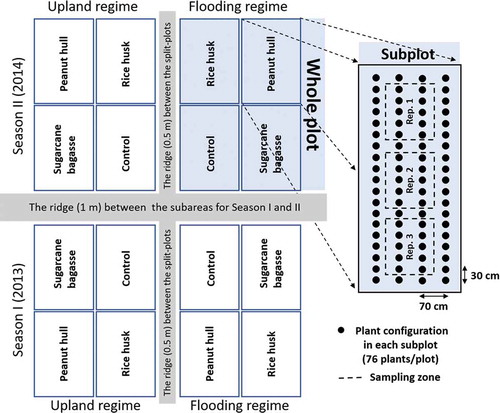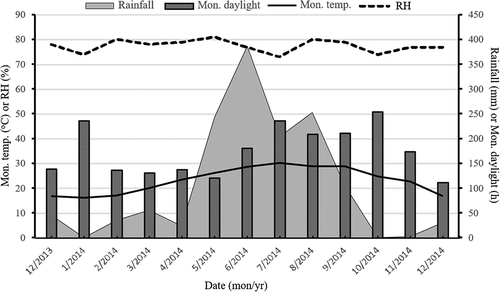Figures & data

Figure 1. Layout of the experimental plots showing the split-plot design with the two treatment factors, water regime (i.e. upland and flooding) and mulching (i.e. control, sugarcane bagasse, peanut hull, and rice husk), assigned in the whole plot and subplot, respectively, for taro cultivation in the two cropping seasons. Season I was the winter cropping from 24 December 2013 to 30 September 2014 and Season II was the spring cropping from 14 March to 31 December 2014. Three sampling zones in a subplot are delineating with the dash lines, in which was one plant randomly selected as the replicates (i.e. Reps. 1, 2, and 3)

Figure 2. Profiles of the monthly temperature (Mon. temp.), relative humidity (RH), daylight hour, and rainfall from Dec. 2013 to Dec. 2014

Table 1. Selected physicochemical properties of the soil (i.e. caly, sand, pH, cation exchangeable capacity (CEC), organic matter (OM), total nitrogen (TN), Bray 1-phosphorous (B1P), and exchangeable potassium (Ex. K), calcium (Ex. Ca) and magnesium (Ex. Mg)) and the compositions of the mulching materials (i.e. ash, OM, N, P, K, Ca, Mg, and ratio of carbon to nitrogen (C/N))
Table 2. Least squares means of the soil properties (i.e. pH, organic matter (OM), total nitrogen (TN), Bray 1-phosphorous (B1P), and exchangeable potassium (Ex. K), calcium (Ex. Ca) and magnesium (Ex. Mg)) for the taro cultivation with different mulching materials under the upland (UPL) and flooding (FLO) regimes in cropping seasons I and II during 2013-2014
Table 3. Least squares means of the weed density during 60, 120, 180, and 240 days after transplanting (DAT) for the taro cultivation with different mulching materials under the upland (UPL) and flooding (FLO) regimes in cropping seasons I and II during 2013-2014
Table 4. Least squares means of the growth factors (i.e. plant height, leaf length, and leaf width) at 240 days after transplanting, for the taro cultivation with different mulching materials under the upland (UPL) and flooding (FLO) regimes in cropping seasons I and II during 2013-2014
Figure 3. Photographs of the corms for the taro plants under (a) upland and (b) flooded cultivations, showing the morphological characters (i.e. shape, size and internal color of raw corm). Scale bar = 2 cm

Table 5. Least squares means of the taro corm attributes (i.e. length, major axis, fresh weight, and yield) for the cultivation with different mulching materials under the upland (UPL) and flooding (FLO) regimes in cropping seasons I and II during 2013-2014
Table 6. Least squares means of the proximate compositions (i.e. moisture (Moist.), starch (Star.), crude protein (CP), crude lipid (CL), crude fiber (CF), soluble sugar (SS), ash, and energy value (EV)) of taro corm from the cultivation with different mulching materials under the upland (UPL) and flooding (FLO) regimes in cropping seasons I and II during 2013-2014